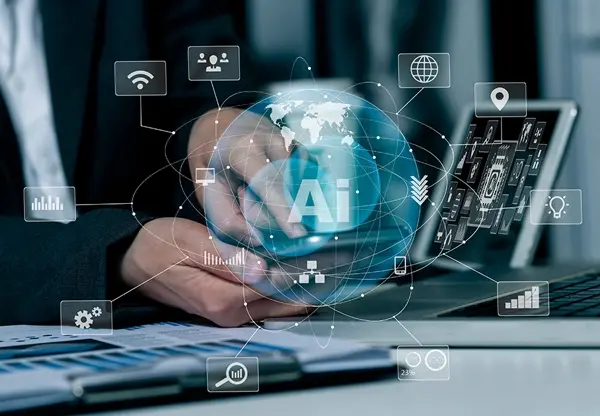Hyperautomation in Business Technology
In this special guest blog, Bill Mariani, SVP of Alliances & Channels at Tungsten Automation explains and explores hyperautomation and the effects it...
6 min read

In this guest blog, Tungsten Automation explores the broader opportunities that Large Language Models (LLMs) offer beyond generative AI chatbots. While tools like ChatGPT have revolutionized personal productivity, Tungsten dives into how AI Agents—combining the intelligence of LLMs with automation—can enhance enterprise-wide processes.
With all the excitement about generative AI focused on chatbots like ChatGPT and image creation tools like Midjourney or Grok2, it’s easy to miss the broader automation opportunities that Large Language Models (LLMs) present.
While AI chatbots can massively boost personal productivity, unlocking enterprise-wide productivity requires a different approach that extends beyond the chatbot. Essentially, chatbots operate as a "brain in a jar" – limited to what they know based on their training data. They lack awareness of the latest events that occurred post-training and cannot access corporate data stored behind firewalls.
To address these shortcomings, techniques like Retrieval Augmented Generation (RAG) can be used to incorporate real-time internet search results, business documents, or data from CRM systems, grounding the AI with more recent and contextually relevant information. This approach boosts the accuracy of responses from the AI model and reduces hallucination (where the AI fills in gaps in its knowledge with plausible sounding but factually incorrect results).
However, true intelligent automation of a business or workflow necessitates more than simply generating an output. AI models must be capable of responding to events and triggering actions based on the data they evaluate. This proactive approach is essential for creating systems that exhibit intelligent behavior and drive tangible business outcomes.
This is where AI Agents come in. Generative AI chatbots can help you create, summarize, discover, and learn; AI Agents are all about doing something - they pair the power of LLMs to evaluate data and predict a desired output (the next word or pixel in a sequence), with the ability to take action through automation.
AI Agents fuse Intelligence and Automation together, creating autonomous systems designed to operate independently, make decisions, and adapt to changing environments. AI Agents promise to address one of the long-standing automation challenges, namely the brittleness of traditional automation processes and robots (RPA). For example, suppose an automated process encounters an error, document or data point that it is not configured to handle. In that case, the process will drop into an exception state, often requiring costly human intervention to correct.
By blending versatility and reasoning capabilities of Large Language Models with workflow and robotic process automation, AI Agents can automate tasks requiring long-term planning and interaction within complex, dynamic settings, marking significant progress towards achieving businesses’ automation and straight through processing goals.
AI agents exhibit several key characteristics, regardless of whether they’re designed for open-world tasks (where they are given a lot of freedom of in terms of the tools and approaches they can use to achieve an outcome) or created to operate only within strict guardrails with a limited set of options available to them. These characteristics include:
A robust framework is essential for effectively utilizing AI Agents. This framework should incorporate the following key factors:
An ideal framework is easy to implement with limited training, so business users without deep technical knowledge can create their own AI Agents and Automations using no-code and Copilot chat UIs. Additionally, given the pace of innovation in the AI space, frameworks should operate independently of any specific Large Language Model to avoid long term vendor lock-in.
Seamless integration with an existing automation platform can also be beneficial. Adding new AI Agents into existing automation business processes and workflows often accelerates AI-powered Return-On-Investment.
Intelligent Automation platforms like TotalAgility easily support AI Agents. We offer two approaches to creating AI agents in TotalAgility, including:
AI Powered Processes: Workflow processes that use LLMs to make decisions or control the path an instance of the process follows.
Each step in the workflow performs a specific task, such as retrieving an email, web page or a document, or extracting data from a connected system via an API or robot. Then, it asks the Large Language Model to evaluate that content and information based on defined criteria specified as prompts and system instructions. The call to the LLM is just another step in the process. Prompts are used to instruct the LLM to return a response in a format the workflow can make use of, for example, as JSON data using a defined format or a Boolean “true / false”. This allows the LLM to respond and control the flow or path that is taken in the workflow.
Custom LLMs: These have specific interfaces that can be interacted with using chat completions or called as part of a workflow.
Custom LLMs are a powerful new feature introduced in TotalAgility 8 that allows AI Agents to be quickly created using low-code tools. Typically, these will make use of a pre-trained foundation models, such as Open AI’s GPT4, and extend this with other automated actions such as searching for relevant content from a corporate knowledge base, pulling data from the CRM, or using internet search results to ground responses in current and relevant contextual data. Custom LLMs can also embed activities on every invocation, such as storing prompts and responses or cross-checking generated output against prescribed criteria or even with the results from another LLM. Once created the Custom LLM can be used to power a Chat component in a web form or called as an activity step in an AI-powered Process.
AI Agents can be tailored to various business needs, providing a wide range of functionalities to address previously hard-to-automate scenarios. Here are some examples:
AI Agents can be deployed across various industries and functions to enhance efficiency and productivity. Here are some specific use cases:
While many code-based tools and frameworks (e.g., LangChain, Azure Semantic Kernel) can be used to create AI Agents programmatically, it is easy to build AI Agents using low-code workflow and automation tools provided by automation platforms like TotalAgility.
The built-in AI Copilot can even help you model the logic in your AI Agent based on your description of what you want to achieve. Simply detail the automation goals, the inputs (events, content, data, channels) and outputs (actions, content, system calls etc.) and the Copilot will create the AI Agent steps for you.
AI Agents represent a significant advancement in the field of automation, combining the intelligence of LLMs with the ability to take action. By leveraging AI Agents, businesses can automate complex workflows, enhance productivity, and achieve greater efficiency. As technology continues to evolve, the potential applications of AI Agents will expand, offering even more opportunities for innovation and growth.
By understanding the core capabilities, key characteristics, and practical use cases of AI Agents, business and technology professionals can better harness the power of AI to drive enterprise-wide productivity and transformation.
But, the potential of AI Agents doesn’t stop there. While a single AI Agent can accomplish a lot, combining multiple AI Agents into collaborative teams enables each agent to contribute its specific expertise to different parts of a business process. Designing AI Agents to be modular and reusable, this allows agents to solve larger, more complex problems within an organized framework, ensuring smooth coordination and optimized efficiency. Designing AI agents to be modular and reusable allows agent teams to function as adaptable units working towards achieving a collective goal, truly unleashing the limitless possibility of advanced AI-driven automation. Using teams of agents, the AI powered automation possibilities are endless.
For all your Tungsten Automation questions and support, contact the experts at Genus!
About the Author
Genus guest blogger Tom Coppock is the Senior Product Management Director at Tungsten Automation, managing teams of sales engineers, solution consultants, and architects. With over 25 years of broad technology experience, Tom specializes in leveraging integration, data, and automation to solve complex business challenges. Tom is currently focused on intelligent automation solutions combining Tungsten Automation's workflow and RPA products with Azure's AI and OpenAI models. He holds certifications in Azure, AWS, and Snowflake. Connect with Tom on LinkedIn.
There's more to learn ~ Subscribe to Genus Blogs!

In this special guest blog, Bill Mariani, SVP of Alliances & Channels at Tungsten Automation explains and explores hyperautomation and the effects it...

As you probably know by now, Kofax recently announced a significant rebrand, changing its name to Tungsten Automation. And with the new name came...

With the latest release of Tungsten Automation's TotalAgility 8.0, an exciting feature has arrived: pre-built document extraction models, available...